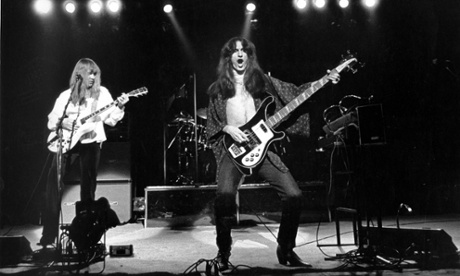Rush: 10 of the best
A career-spanning selection from the great Canadian trio, inspired by Ayn Rand, Coleridge and suburban alienation
Rush onstage in 1978. Photograph: Fin Costello/Redferns
1. By-Tor and the Snow Dog
Rush started out as a straightforward and somewhat derivative hard rock act. But when drummer and lyricist
Neal Peart joined for their second album
Fly By Night, things started to get more interesting. Yes, the Dungeons and Dragons-style lyrics do sound a bit corny nearly 40 years on, but what makes this track is its extended instrumental middle section with a Dazed and Confused-style guitar workout from Alex Lifeson.
2. 2112
"Attention planets of the Solar Federation. We have assumed control." This side-long epic marked the point at which the
Led Zeppelin-style hard rock and the Genesis-style progressive rock sides of Rush's music, previously at uncomfortable odds with one another, came together in a coherent whole. Its ambitious scope and science fiction themes put Rush on the map and gave them their musical identity. Their namechecking of the controversial libertarian novelist
Ayn Rand as an influence got them wrongly smeared as extremely right wing by NME, but the storyline about a boy rebelling against a religious dictatorship contains none of the things that made Rand a pin-up for adolescent sociopaths of all ages. Not that it has ever stopped the usual suspects from using it as an excuse to take cheap shots at the band.
3. Xanadu
Xanadu represents the high point of the 70s pomp-rock phase of Rush's career. With lyrics based on the Samuel Taylor Coleridge poem
Kubla Khan, it goes way beyond their previous power-trio approach with added keyboard, bass pedals and an array of orchestral percussion. It builds slowly, with a minute and a half of percussion and electronic effects before the whole thing bursts into life with Alex Lifeson's magnificent spiralling guitar figure, and another three minutes before Geddy Lee's vocal comes in. It's one of the defining symphonic rock epics from the 70s, with good reason.
4. La Villa Strangiato
Subtitled "An exercise in self-indulgence", this number does precisely what it says on the tin, and as an instrumental track it's recommended to anyone who is allergic to Geddy Lee's helium vocals. After beginning with Lifeson's frenetic flamenco guitar it builds into a kaleidoscopic piece filled with unexpected twists and turns, and an overwhelming sense of fun throughout its nine minutes. With sections entitled "A Lerxt in Wonderland" and "Monsters!", you can feel the band enjoying themselves while they play this.
5. Witch Hunt
By the early 1980s Rush had already had a chart hit with
Spirit of Radio and were writing shorter, more focused material.
Moving Pictures, released in 1981, remains one of their most highly regarded albums, and it would be easy to pick any song as an example of Rush at their peak. Lifeson's growling, menacing riff matches Peart's lyrics drawing parallels between pitchfork-wielding 17th-century Puritans and the then rising moral majority of Reagan's America.
6. YYZ
With the move towards shorter songs, Rush stopped slotting lengthy instrumental workouts into the middle of other songs and broke them out into separate numbers in their own right. This track is an early example, and remains one of the best. A rare case of an instrumental with its own title, the staccato rhythm of the opening section spells out YYZ, the code for Toronto airport, in Morse code. It's still a live favourite, often a vehicle for Neal Peart's epic drum solo.
7. Subdivisions
Signals, released in 1982, marked a further shift in sound, with a move towards a sophisticated art-pop that owed as much to new wave as it did to 70s prog rock. Its synthesiser-driven opening number typified this new approach. Peart's lyrics capture the essence of suburban alienation ("Conform or be cast out"), and are a good example of why he's as revered among Rush's fans as Morrissey is by the Smiths'.
8. Afterimage
This eulogy to an unnamed dead friend is a standout from
Grace Under Pressure, released in 1984. Two things make this remarkable musically; one is the way Peart's drums take the role of the bass while Geddy Lee plays keys, and the other is the guitar textures that Alex Lifeson weaves throughout the song. These showed how he had progressed well beyond the archetypal classic rock guitarist to something multifaceted and altogether more impressive.
9. Animate
As the 80s rolled into the 90s Rush changed their sound yet again, taking a back to basics power-trio approach without the synthesisers and layers of guitar effects that typified their late 80s output. The 1993 album
Counterparts was a return to form after a couple of rather bloodless predecessors, and in its opener
Animate they rock out in a way they hadn't done for years.
10. The Garden
Even if the 2012 concept album
Clockwork Angels wasn't quite a career-defining masterpiece, its closing ballad
The Garden is a thing of beauty. A full 37 years separate this from By-Tor and the Snow Dog, and the two songs are light years apart musically. But they are the same band; an unchanged lineup across five decades that saw many musical fashions come and go. Rush have outlived them all and remain relevant long after almost all of their contemporaries have burned out.


